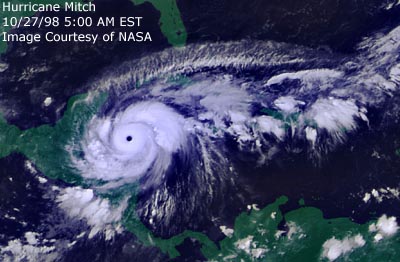Education Links
Leaving Cert
 Maths
Maths
 French
French
 English
English
 Chemistry
Chemistry
 Physics
Physics
 Biology
Biology
 Economics
Economics
 Spanish
Spanish
 Geography
Geography
 History
History
Junior Cert
In October 1998 Hurricane Mitch resulted in the deaths of over 10,000 people in Central America. It was the deadliest Atlantic hurricane in 200 years.
5. Limiting the destruction
There are two ways to limit the damage- Modifying the hurricane
- Forecasting and evacuation
A better approach is to improve forecasting, warning and evacuation systems. The reason so few people die in the US when one of these storms hit is due mainly to prior warning and evacuation. Since the 1960's we can track the movement of storms across the Atlantic and give warnings. In the US communications allow the population at risk to be warned and the society can afford the evacuation. Now, consider the case of Bangladesh. In 1972 200,000 drowned as a result of hurricane flooding. Bangladesh is densely populated, low-lying and very poor. How do you warn millions that don't have radios or TVs? How do you move millions of people at short notice when the bicycle is the main form of transport?
6. Hurricane Mitch and its legacy
On October 22 1998 a tropical depression was spotted moving slowly toward the Caribbean. Within four days it had developed into a category 5 hurricane and would become the most devastating Atlantic hurricane of the 20th Century. Mitch moved slowly westward until it eventually reached landfall at the Honduran coast. After moving slowly overland it eventually turned northward, heading back into the Caribbean and the Atlantic.
A satellite image shows the eye of the storm coming in off the Caribbean approaching Central America
Its legacy was a trail of death and destruction in Central America, chiefly in Honduras and Nicaragua. Of the 11,000 that perished, 6500 died in Honduras and 3800 in Nicaragua. Most of those who died in Honduras drowned in floods, and in Nicaragua 3000 died in a massive mudslide. The fragile economies of two of the world's poorest countries were devastated. In Honduras whole villages were washed away leaving 1.2 million homeless, 70% of crops and almost all roads were destroyed. It is estimated that the damage set back development by thirty years!
One of the astonishing stories from Mitch concerned a mother that lived 1km from the nearest river and 3km from the sea. When the flooding began and the storm surge arrived the distinction between river and sea disappeared and she was washed out into the Caribbean. She survived by clinging to debris and eating fruit floating in the water. When she was found six days later she was 120 km away from her home.


